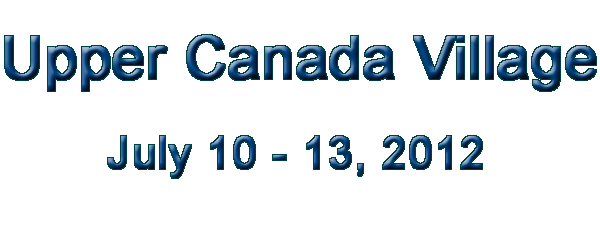|
July 10, 2012
We had been craving a motor home trip for some
time. The rig has been in winter storage since February . . . that's
far too long and we were dying to get away. A short trip made sense so
we decided on Upper Canada Village. It's an historical park about 145
kilometres (90 miles) from home.
We got away from home at about 10:20 a.m. and
pulled into Upper Canada Campground at noon. It's only 4 kilometres
from here to the historical village.
By 12:30 we had our shady campsite all set up
and enjoyed a bite of lunch in the RV. We spent much of the afternoon
sitting in our lawn chairs, under the awning, reading, playing with Zak and
Blue and watching the world go by. Ahhh!
We took a drive to explore the area and get our
bearings and within an hour we were back to the campsite.
At 5:00 Carol fed the dogs and by 5:45 we headed
out to find dinner. Just a few miles down the road we stopped at a
local diner . . . it was less than stellar. Definitely not a do-over!
We sat out and read our books until daylight
gave out and mosquitoes drove us inside. |
|
|
July 11, 2012
We had a leisurely start to the day. We lazed
around and played with the dogs until 9:00 a.m. before leaving on our way to
Upper Canada Village. We stopped briefly at Crysler Park, the site of a
battle in the War of 1812. At the Battle of Crysler’s Farm the British Army,
supported by Canadian Militia and Mohawk warriors repelled an American force
three times their number. The battlefield memorial park is beside the
historical village and has a sandy swimming area in the St. Lawrence River. |
|
The river, the boundary between Canada and the
USA, is less that a mile wide in this region. For our American friends,
Upper Canada Village is on the north side of the river about 8 miles due
west of Massena NY. |
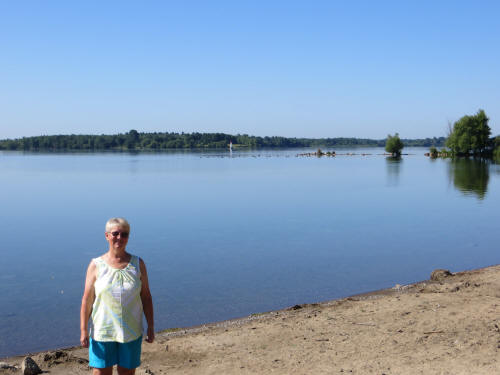
That's the USA on the other side. |
|
Construction of the historical park began in
1958 in conjunction with a massive canal construction project. It was a
joint effort between Canada and the USA to permit ocean going freighters to
access Great Lakes ports. In order to bypass a 1 ½ mile stretch of rapids
known as “The Long Sault” three massive dams were built.
The three dams resulted in the flooding of 22,000 acres of land on the
Canadian side of the river. The project required the relocation of 7 ½
villages and in the process over 525 buildings were moved to higher ground.
Many historic buildings were moved to Upper Canada Village during the seaway
project and the historical park opened in 1961. It has grown significantly
since then!
We arrived at 9:30 just as the park was opening and we almost had the place
to ourselves. We spent a few minutes in the Welcome Centre where displays
and a short movie set the stage for us. They explained the significance of
the Battle of Crysler’s Farm and the historical significance of many of the
building which were moved in 1958. |
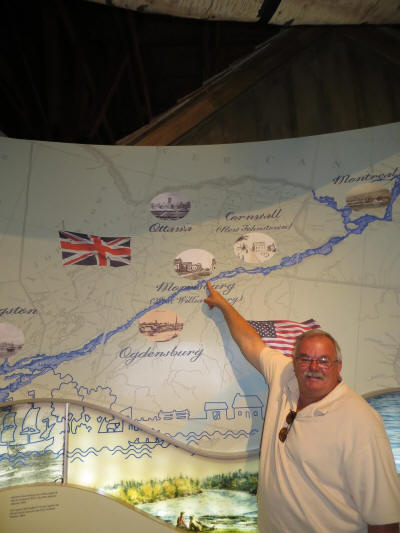
Here's where we are - half way between Kingston and
Montreal |
|
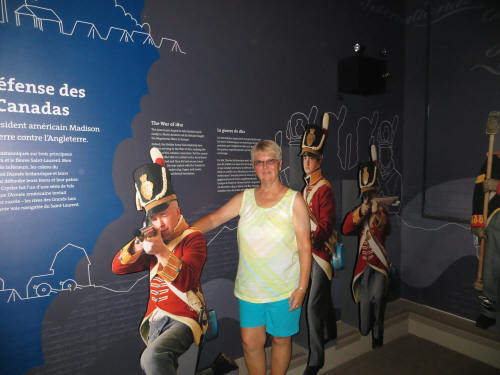 |
Then we entered the park. Wow! It’s terrific. The time setting is about 1860
and the theming is terrific. The costuming is authentic and the employees
all stay pretty much “in character.” And they all really work. The saw mill
cuts logs into lumber, the grist mill grinds grain into flour, the bakery
bakes bread, the tin shop makes lamps and other things, the cheese factory
makes cheddar cheese, the broom maker makes brooms out of sorgum tassels,
the dressmaker sews dresses and the shoemaker makes shoes. The dresses and
shoes are all used as costuming for the employees and most of the other
product can be purchased in the gift shop. We brought home a block of cheese
and a loaf of bread still warm from the oven. |
|
Each and every building is staffed by workers in
period costume and they explain who they represent, what they are doing and
why. It’s a real learning experience and it’s fun! They even have a formal
teaching program for children. There were kids in period costume almost
everywhere we looked. In the Lutheran Minister’s home two young girls were
learning how to sketch. In the Tinsmith’s Shop two young boys and three
girls were making cookie cutters out of tin. What an interesting teaching
opportunity . . . and the kids looked to be captivated by the experience.
Our first stop was the water-powered saw mill. A man outside the mill was
hewing huge logs into square beams to repair a crooked wall in the saw mill.
I sure wouldn’t want his job! |
|
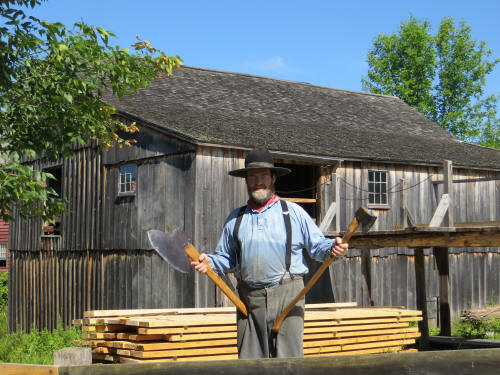 |
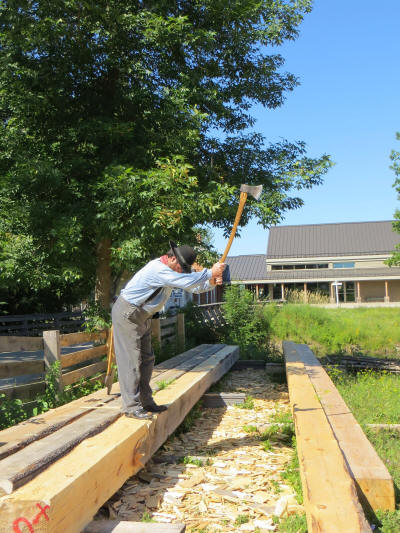 |
|
We visited Cook’s Tavern, the Broom Maker's
Shop, Christ Church, the Lutheran Minister’s house, the Masonic Lodge Hall,
the Tinsmith Shop, Crysler’s Store, the Bakery, Willard’s Hotel, Crysler
Hall, Robertson’s house, the Doctor’s house, the Dressmaker’s Shop and
finally the Cheese Factory. |
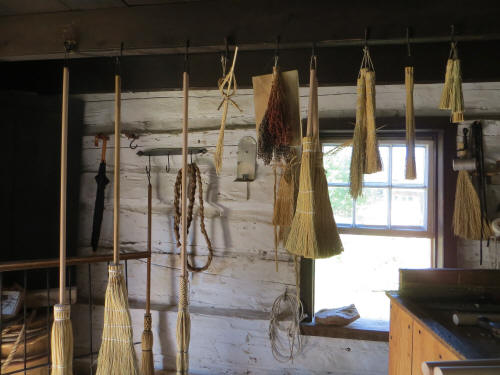 |
|
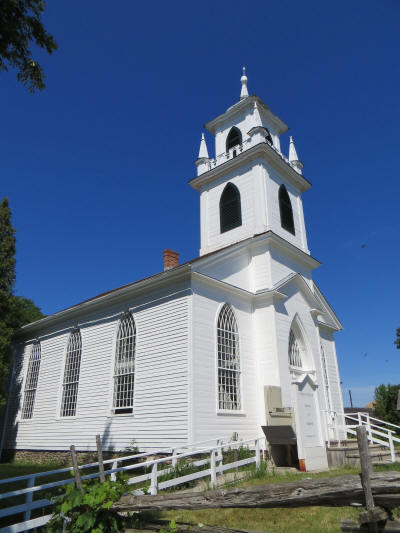 |
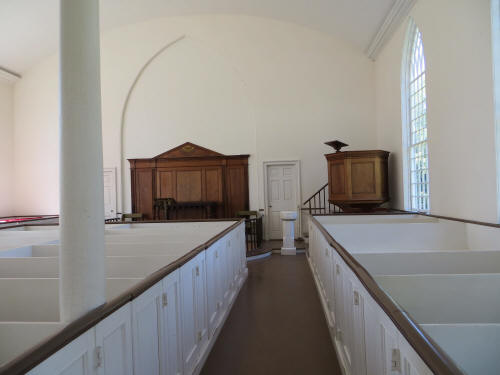 |
|
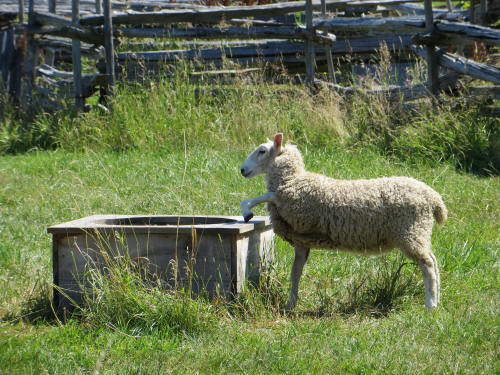 |
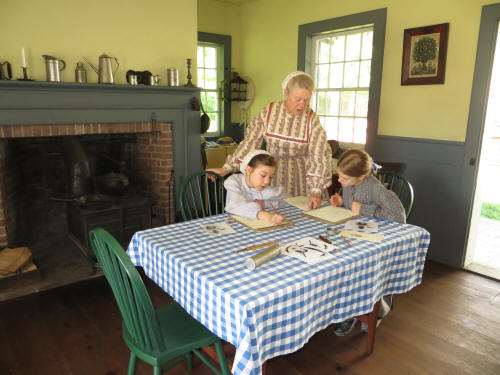 |
|
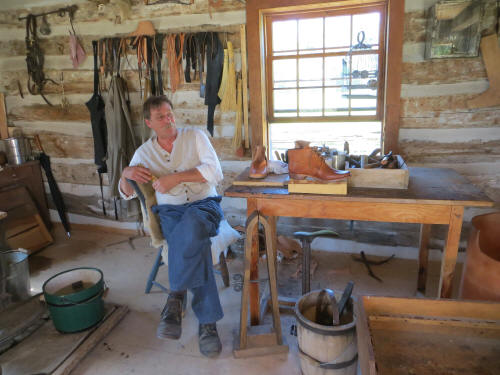 |
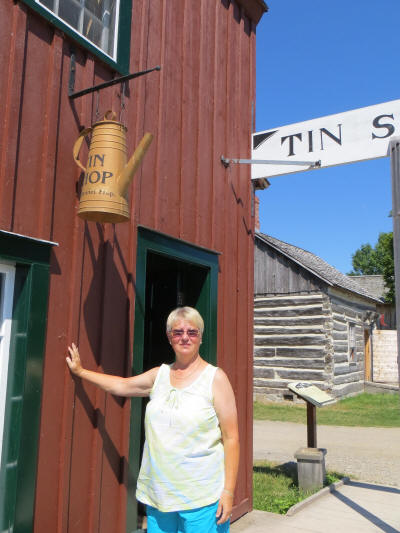 |
|
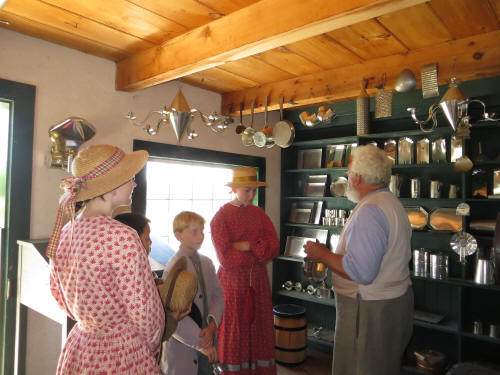 |
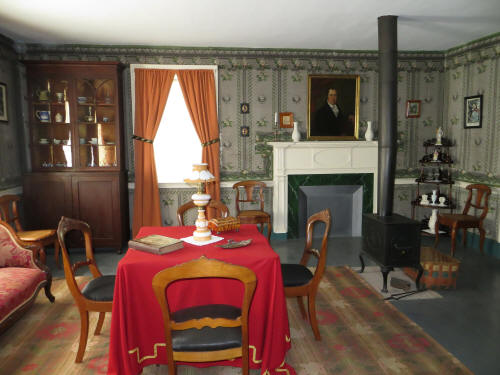 |
|
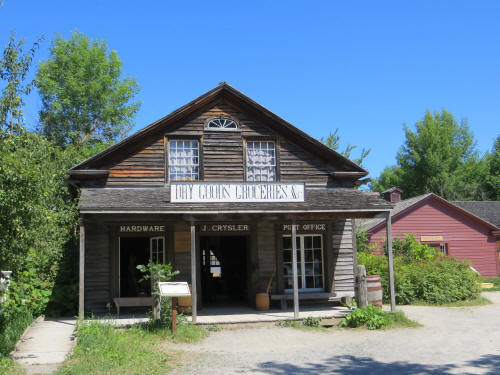 |
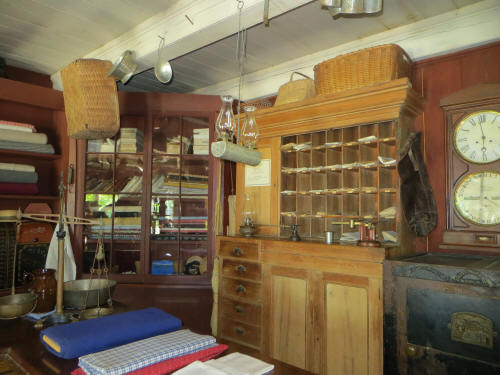 |
|
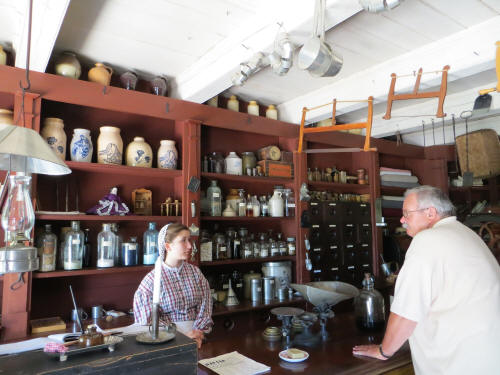 |
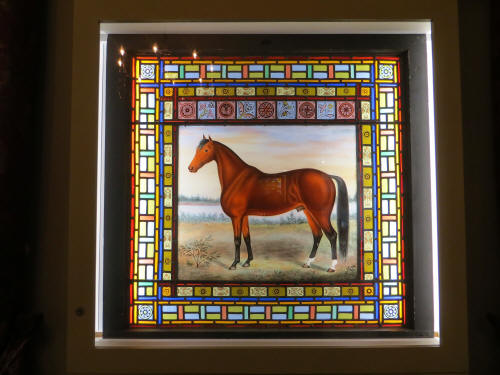
Painted Glass |
|
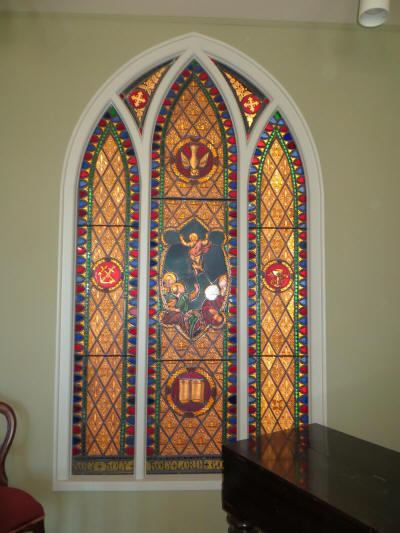
Stained
Glass
|
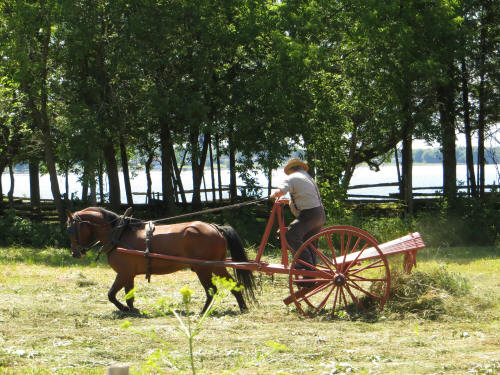
Raking
hay |
|
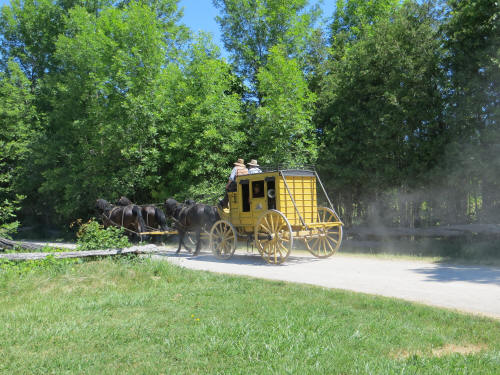 |
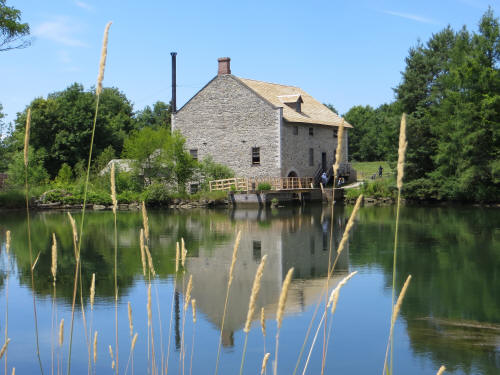 |
|
My formerly poopy knees held up pretty well but
by 12:30 they were feeling a bit flatulent. We had covered about half of the
park so we decided to stop at the Harvest Barn (tucked away out of sight and
thankfully air-conditioned) for a bite of lunch. Then we headed back to the
campground for a short rest.
By 2:00 p.m. we had loaded the dogs in the car and headed east to drive the
scenic Long Sault Parkway. Sault is a Mohawk Indian word meaning rapids and
the parkway runs along the area where the 1 ½ mile rapids used to race. Wow
– it’s pretty. When they dammed the river and raised the water level the
highest hills in the area formed an arkipalego
archopalego string of islands, in the middle of the river. |
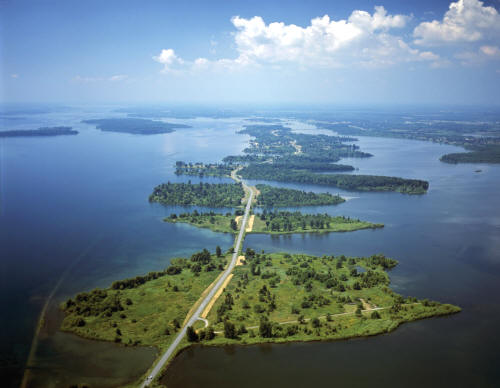 |
|
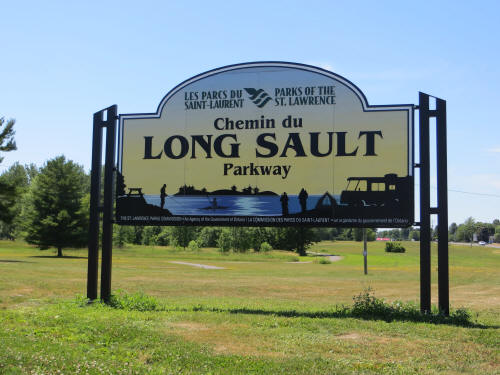 |
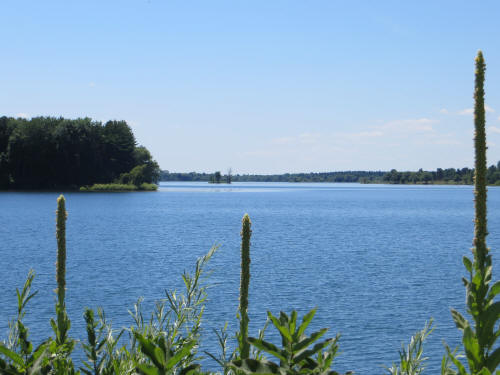 |
|
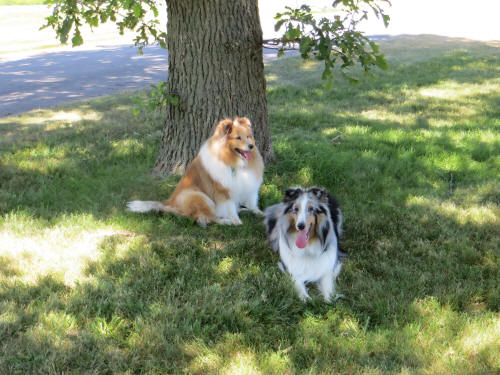 |
It is all park land with campgrounds, picnic
areas, beaches and boat launch ramps. The parkway has a 55 kph (35 mph)
speed limit and wide bicycle lanes on both sides. There were scores of
cyclists enjoying a beautiful sunny day!
We finished our strenuous tour with an ice cream
cone before heading back to the campground. After feeding the dogs we headed
into the nearby Village of Morrisburg and had a very good pizza for dinner.
By 8:00 p.m. we were settled in for the night. The following day we planned to finish our tour of
Upper Canada Village and then head west, upriver, to see a submerged lock
from the old canal and one of the “new” locks build in 1958. |
|
|
July 12, 2012
Today we headed back to Upper Canada
Village!
Once again we were there at 9:30 a.m. for park opening. We watched while
they harnessed the horses and hitched them to a few wagons. Then we hopped
on one of those wagons and caught a lift to the far end of the park to
continue our tour. |
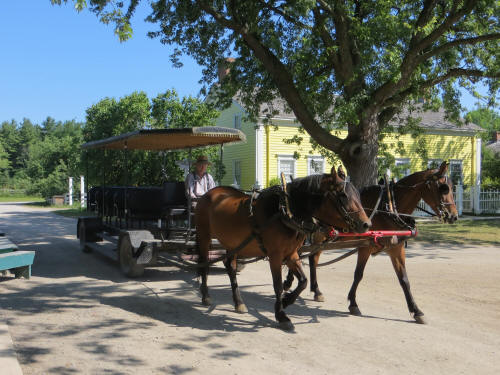 |
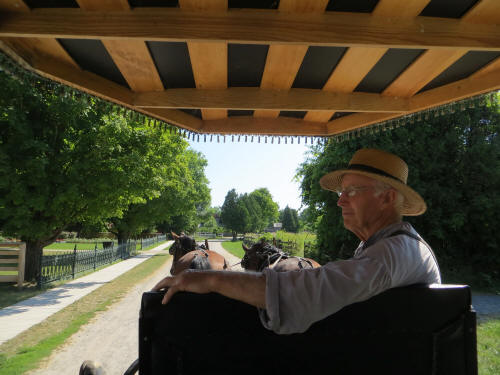 |
|
The first stop was at Louck’s Farm. It’s a real
working farm, authentic to the 1860’s setting. Some young girls, part of the
youth program they call “Time Travellers” were making cookies in the
farmhouse kitchen. Others were getting a piano lesson in the parlour. |
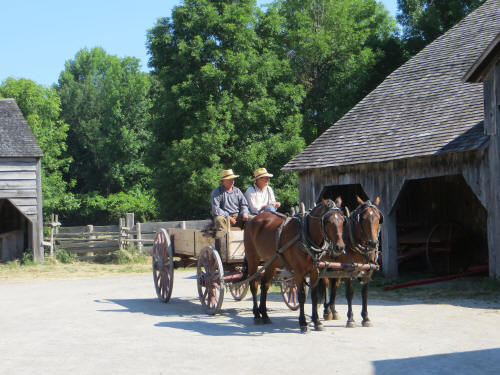 |
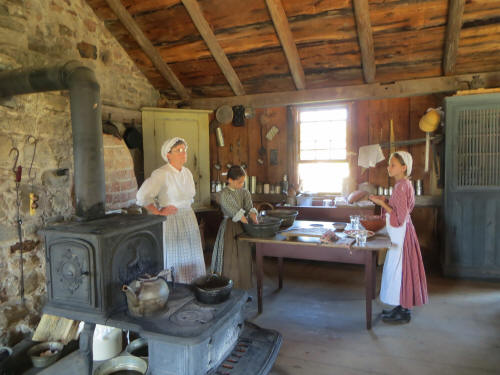 |
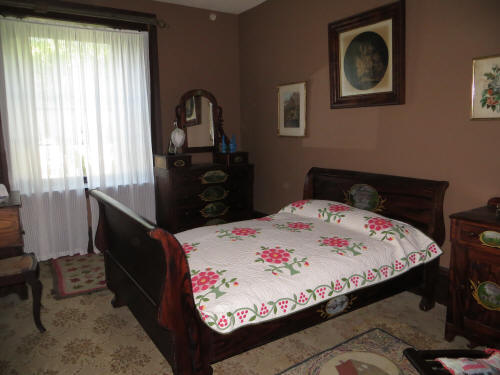 |
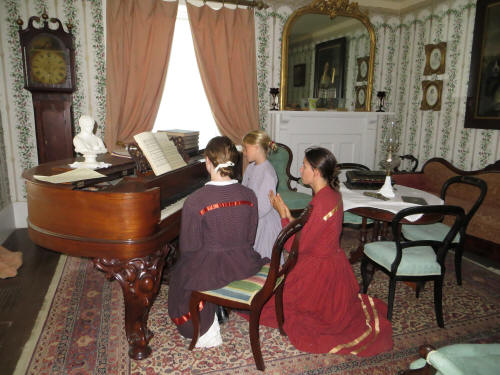 |
|
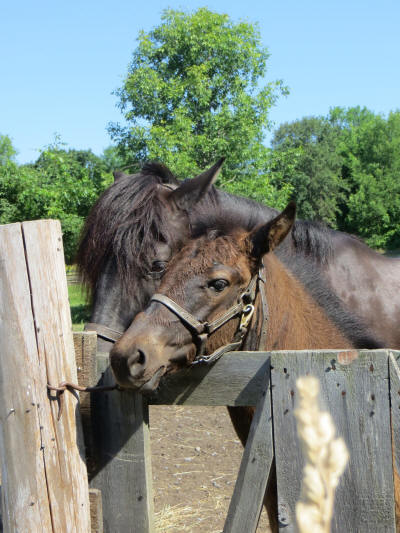 |
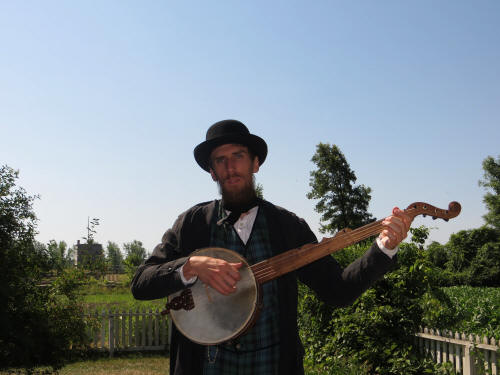 |
|
Then we stopped at the one-room school. |
|
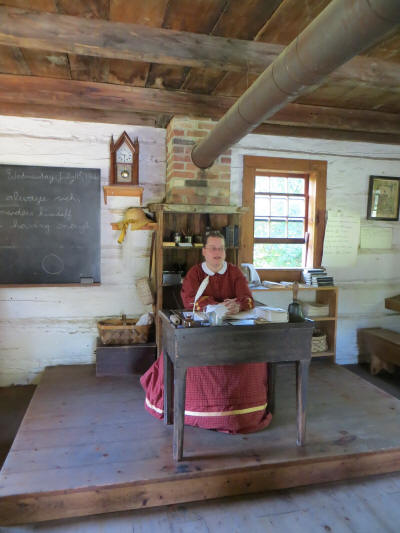 |
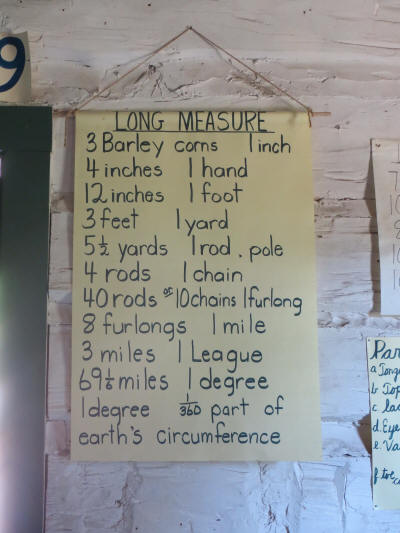 |
|
In the Newspaper Office two young girls were
learning how to typeset pages for the newspaper press. |
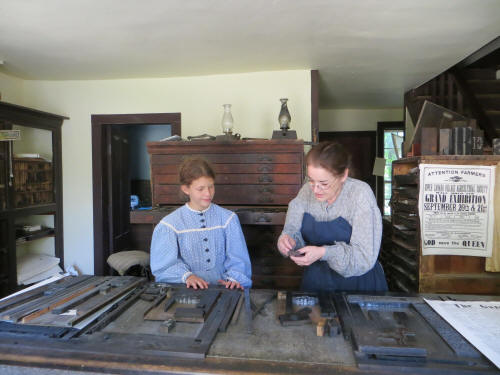 |
|
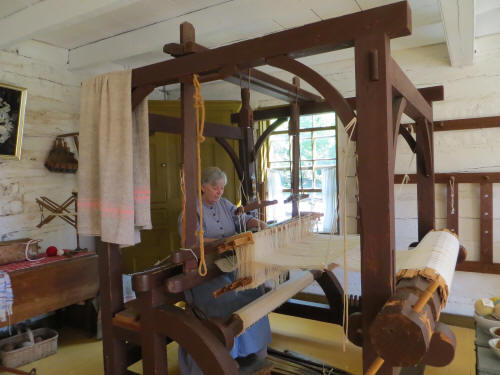 |
In the McDairmid Home the lady of the house was
weaving on the loom.
|
|
At the Ross Farm Mrs. Ross was quilting. |
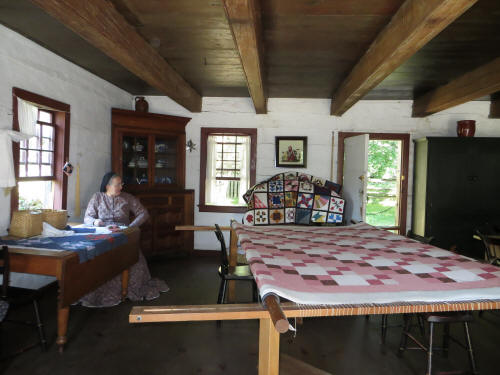 |
|
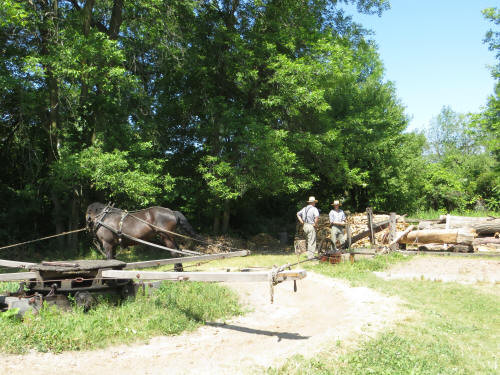 |
Then as we walked past the drag saw the horse
started his loop. This is an amazing device. The horse walks a circular
course and powers the saw. One circuit for the horse makes 40 strokes with
the huge saw blade. Saves a lot of man-power. |
|
At the cabinetmakers we saw some amazing
furniture which they had crafted then stopped at the blacksmith shop where a
young man was making a “J hook” under the smithy’s watchful eye.
|
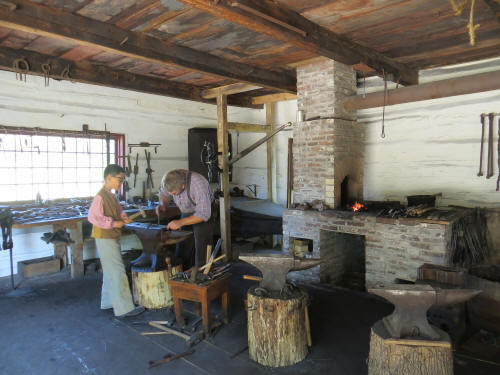 |
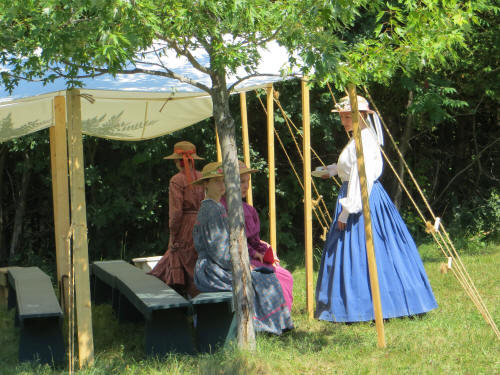 |
Our last two stops were the grist mill and the
woollen mill, both powered by water. The grist mill was grinding white
flour. |
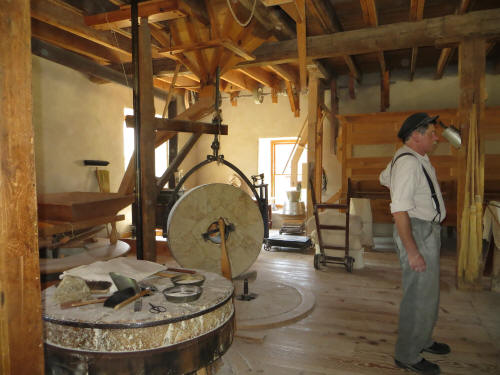 |
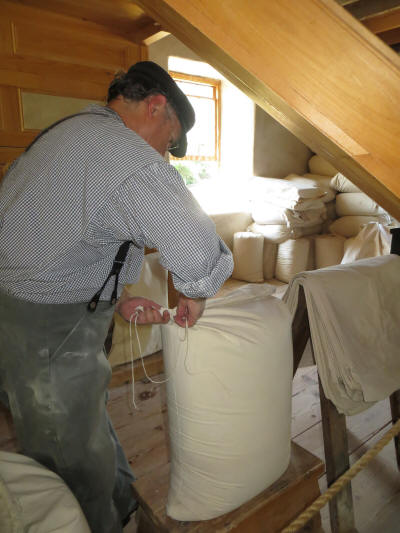 |
|
The woollen mill was carding wool, spinning it
into yarn and then weaving the yarn into fabric.
|
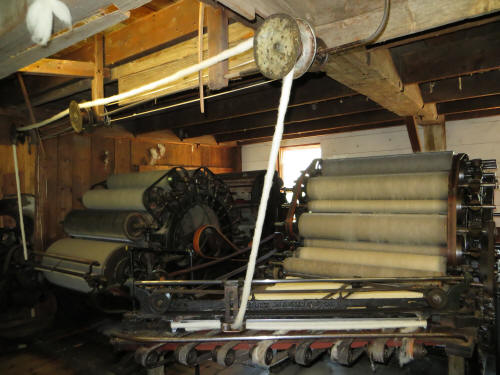 |
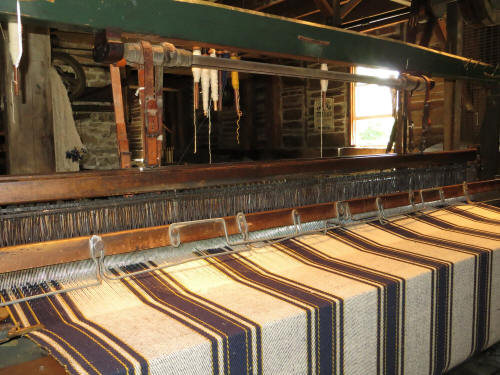 |
|
This is an amazingly self-reliant place, making
almost everything they need using period-appropriate technology. The fact
that they train so many children at the same time is just astounding.
They have several programs for different age groups but the most popular is
the “Time Travellers” Discovery Camp for boys and girls aged 9 to 13. This
is a residential program, the children are closely supervised and live in
two-hundred year old houses which are “behind the scene” on the property.
The houses have electric power, running water, modern plumbing and air
conditioning but those are the only modern amenities. The children have no
TV, iPods, computers, etc. They dress in period costumes and play period
appropriate games. Children come from all over Canada and the USA for the
Time Travellers Camp and many come back year after year.
We finished our tour of the park at about 12:30 and headed back to the RV
for a bite of lunch.
At about 2:00 we loaded the dogs in the car and headed east down the river
to visit Cardinal and Iroquois, two towns which were partially relocated in
the 1950’s. At Iroquois there is a huge lock, part of the new Seaway System.
The lock is 984 feet long and 80 feet wide. For purposes of comparison,
locks in the current Panama Canal are 1,050 feet long and 110 feet wide. |
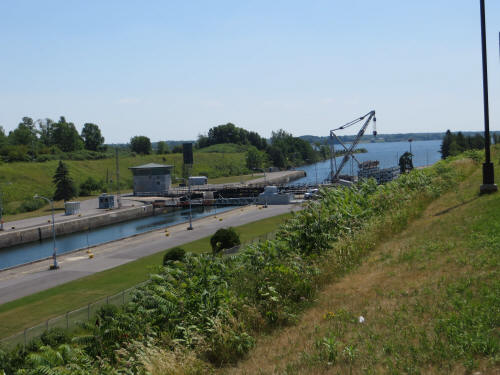 |
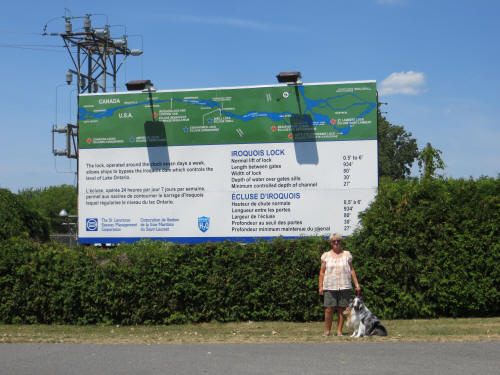 |
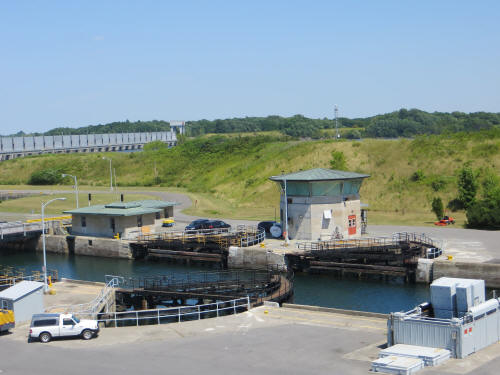 |
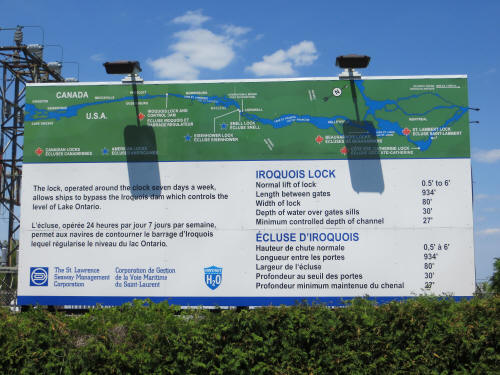 |
|
Also at Iroquois we visited the site of an old
canal lock, so much smaller than the ones built in the 1950’s.
We were back to the campground before 4:00 and
began packing things up. We were heading home the following morning.
We had a very nice dinner at the McIntosh Conference Centre in nearby
Morrisburg and then
spent a quiet evening with the dogs. |
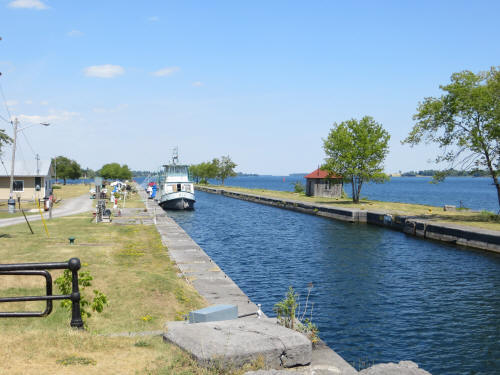 |
|
|
July 13, 2012
Wow! What a treat. We pulled out of
the campground at 8:00 a.m. and we were home at 9:45 a.m. Sure beats
that four day drive back from Florida!
We really enjoyed the time we spent at Upper
Canada Village and we had a great time exploring the beautiful area around
the St. Lawrence Seaway locks. The only drawback to the trip was the
campground. It was pretty old and tired. We selected Upper
Canada Campground because it was just a few miles from the historical park,
it had a pool and WiFi. We didn't go near the pool and the WiFi didn't
work. We saw some absolutely gorgeous Provincial and National Parks
with riverside camping facilities which had much more to offer than the one
we were camped at. It didn't seem worthwhile to move but if we ever
head that way again we will stay at one of the riverside parks. |
|
